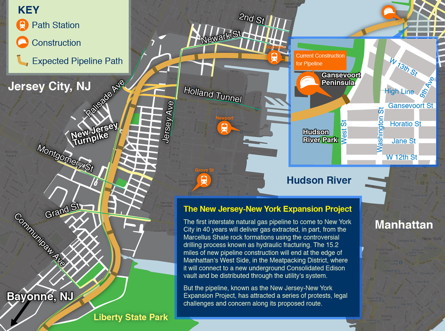Adapting New York City For Monster Storms
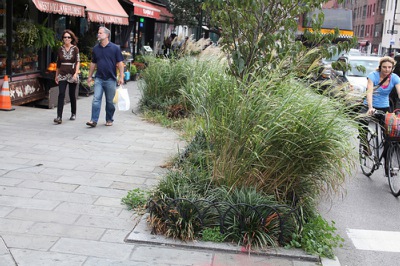
NEW YORK — Outside a 24-hour deli a block away from the 169th Street F train station in Jamaica, Queens, a brushed metal subway grate that wouldn’t look out of place at the Museum of Modern Art juts from the ground.
It’s about 10 feet long and slopes upward in undulating waves from six inches on one side to a few feet tall on the other.
As Hurricane Sandy drenches the city, the grate is one tool in the Metropolitan Transportation Authority's arsenal for reducing flooding in the subway system, which was shut down last night ahead of the storm.
The agency has spent $117 million to deal with floodwaters, including infrastructure changes less visible to the public, such as flood barriers around train yards and new pumps.
With a warmer, wetter future caused by global warming all but certain, city developers in the public and private sectors have been making investments in infrastructure that can lessen the impact of extreme weather.
But some policymakers and analysts say there’s simply not enough financial incentive to prepare New York for whatever climate change may bring.
The grate, for instance, was built with money from the MTA’s capital budget, which is typically used to buy things like buses and track signals. "You are stealing money from the core mandate of public transportation, and raising grates,” said Projjal Dutta, the director of sustainability for the MTA.
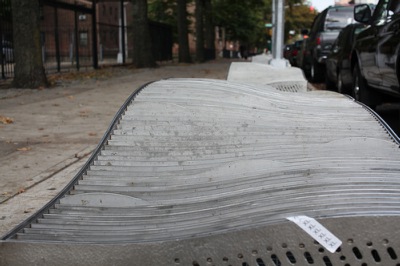
"There could be cheaper solutions to this, but people wouldn't deal with them being plunked down because sidewalks are precious commodities in New York City,” said Guido Hartray, who helped design the grates. All images by Peter Moskowitz.
The private sector is also struggling to meet the challenge, with developers skeptical about higher costs that can come about from sustainable buildings.
Stephen DelPercio, who works at Green Buildings NYC, a real estate company with a focus on eco-friendly leasing, said that developers of private real estate usually build with the idea that they will sell the building in 10 years, at most.
He said that short time scale doesn’t give anyone incentive to build with things like flood protection in mind
“Until it's smacking us in the face, behaviors aren't going to change," he said.
Cecil Scheib, the advocacy director for the Urban Green Council, a green buildings advocacy group, agreed that without government pressure, there’s no reason for buildings to be designed differently. He said that whereas “green” can be used as a marketing tool, “prepared for disaster” cannot.
"Right now, for a developer, you are basically selling a downer,” he said. “No one wants a downer."
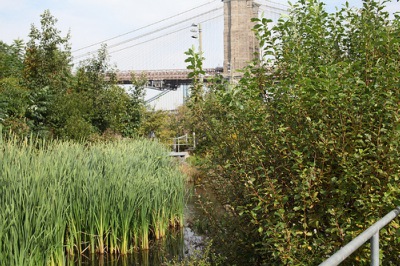
Brooklyn Bridge Park was designed to withstand storm surges.
Fiona Cousins, an architect with global engineering and design behemoth Arup, said clients often ask how much it will cost to adapt designs for climate change and whether it is worth it. She said the answer is often, “no.”
Arup helped develop the $1.4 billion Fulton Street Transit Center in downtown Manhattan, which is being built to withstand flooding. The company also was part of a development team for London’s flood barrier, which is meant to protect the city from storm surges.
Incentive in the public sector is lacking, too. At a time of tight budgets, designing the city for 50 years down the road can seem like a low priority, even though one of Mayor Michael Bloomberg’s biggest mandates has been to make the city greener and to prepare it for the effects of global warming.
In 2007, the mayor’s office released PlaNYC, a 200-page blueprint for city agencies, residents and businesses to help make New York more sustainable. The plan called for a 30 percent reduction in greenhouse gases from 2005 levels by 2030, largely by making buildings more energy efficient. It promised $2 billion for storm water infrastructure and other upgrades to deal with rising sea levels and increased rain.
In August, the City Council passed legislation that would make permanent a climate change panel and task force created by the mayor's office in 2008. The legislation also enlarges the scope of the panel and task force to focus their efforts on "vulnerable populations," such as the elderly, children and the poor.
But Cousins said New York is behind when it comes to spending money on large infrastructure projects. “In New York, nobody does anything at this point,” she said. “I don't think it's likely that New York is going to implement that barrier.”
Many developers, real estate agents and others involved in building the city’s infrastructure recognize that more can be done, through economic incentives and regulation, to prepare New York City for a warmer future. But they do see signs of hope.
"Everyone has woken up,” said Russell Unger, director of the Urban Green Council. “Five years ago, no one was really acknowledging that adaptation was a problem. Maybe once something floods, they'll recognize they need to move."
Straight through the Rockaways, Oversight of New Pipelines is Split
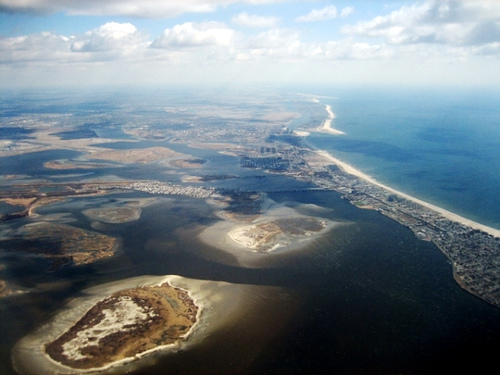
NEW YORK — A plan to construct a new chain of natural gas pipelines from the Atlantic Ocean off the Rockaways through Jamaica Bay to the city is fueling anxiety from residents and some lawmakers because of its complexity and its potential impact on the surrounding community and coastal habitat.
The pipeline project is being championed by the mayor’s office, which says it is critical for meeting the demands of the energy-hungry metropolis, and National Grid, whose customers in Brooklyn and Queens will largely benefit from the increased supply that the project will bring.
Much of the project takes place in the 26,000-acre Gateway National Recreation Area. A new pipeline will extend from an existing gas line two-and-a-half miles off the Rockaway coast and run underneath Jacob Riis Park toward Jamaica Bay. Two pipelines will then run underneath the Bay, connecting to a proposed gas metering station to be housed in a historically significant hangar at Floyd Bennett Field. A separate pipeline will run from the meter station to an existing gas main on Flatbush Avenue in Brooklyn.
In terms of public review, the project has been split in two. Construction of the the coastal pipeline and meter station is being managed by Oklahoma-based Williams Companies. This section of the project is under federal jurisdiction and is subject to a full environmental review and public comment period.
National Grid is managing construction of the pipelines underneath Jamaica Bay, and along Flatbush Avenue. This section of the project is under the city’s jurisdiction. An assessment of potential environmental impacts associated with the project determined that there was no need for a full review. The determination also eliminated the requirement for a public comment period.
Construction on the first of three phases of the project is expected to begin later this year, with a project completion date of 2014.
Some residents have asked why there has not been more public input on key decisions, such as the siting of the 60,000-square-foot gas metering facility at Floyd Bennett Field.
“The public doesn’t have an understanding of what’s involved,” said Karen Orlando, a local resident and former member of the Coalition Against the Rockaway Pipeline. “It’s very hard for regular people to understand the process … how all the pieces fit together.”
The project requires approval and oversight by various city, state and federal agencies. The National Park Service needed Congressional authorization to permit construction of the meter station at Floyd Bennett Field. Legislation approving construction of the pipeline and related installations within Gateway passed the House earlier this year, and the U.S. Senate in September.
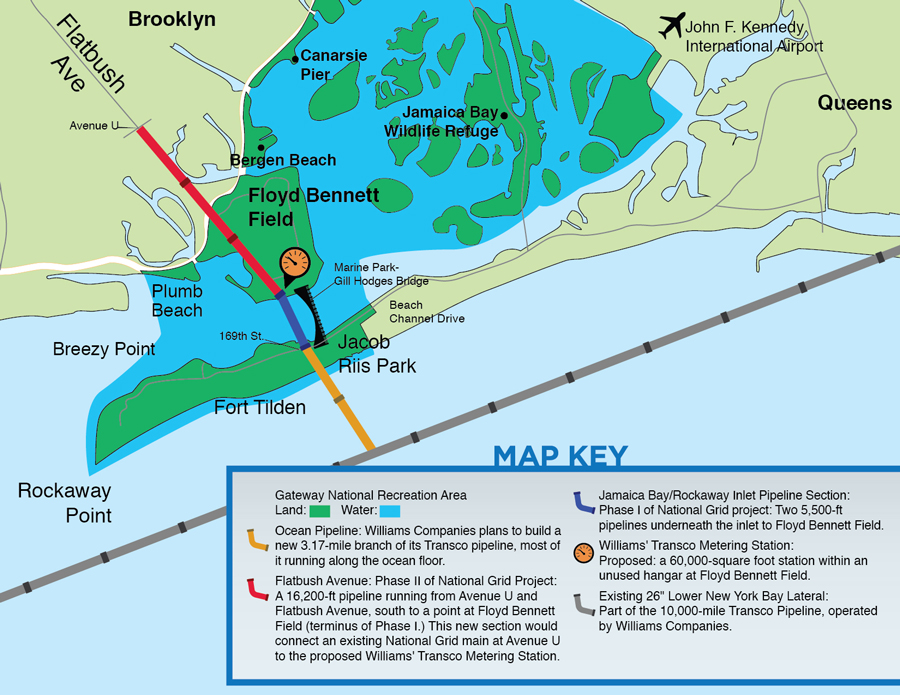
Map of the proposed project. Click to enlarge. Image courtesy MetroFocus/Kevon Greene.
Demand for Natural Gas
National Grid requested Williams Companies, a major energy infrastructure company, to build the extension of its Transco pipeline off the Atlantic Coast to “meet the expected demand for natural gas in New York City and reinforce its existing system.”
Project documents filed with the Federal Energy Regulatory Commission note that 68 percent of residential households in Brooklyn and Queens used natural gas for space heating in 2008, an increase of over 130,000 households since 2000.
The pipeline will also “ensure reliability for the Rockaways,” said National Grid spokeswoman Karen Young.
Adding to the demand for natural gas, the city passed regulations that call for replacing the pollution-generating heavy heating oils used in buildings with substantially cleaner fuels by 2030. Policymakers expect that natural gas will be among the most attractive options because of its low cost and decreased emissions.
Young noted that “over the next five years, demand for natural gas in National Grid’s NYC service area is forecasted to increase 15 percent, representing an additional 25,000 residential, commercial, industrial and multifamily customers.”
Deputy Mayor Cas Holloway said in an interview with Gotham Gazette last month that projects like the Rockaway pipelines, and an interstate pipeline that is being built between New Jersey and Manhattan, will ultimately “save lives” because they will help reduce the reliance on dirty-burning heavy oils that contribute disproportionately to air pollution.
He said the projects “are being done with minimal environmental impacts, and they ultimately are going to have a huge public health benefit.”
But others are not so convinced that the project won’t have much impact.
State Sen. Joseph Addabbo of the 15th senate district said there are “a number of environmental issues. I’m very concerned at this point. My people are scared.”
City Councilman Eric Ulrich, who is challenging Addabbo for his Senate seat, said that National Grid “has a lot of convincing to do,” adding that he didn’t "see how having National Grid tunneling under Jamaica Bay is going to do us any good.”
Environmental Concerns
Local environmentalists argue that the project could devastate a critical habitat off the coast of the Rockaways, where striped bass, blue fish, lobsters, spider crabs and other marine life can regularly be found.
And the city says the Jamaica Bay area is an “integral part of the larger, regional ecosystem” and that it hosts over 325 species of birds and 50 species of butterflies. It is also a favorite stop for migratory waterfowl. The 18,000-acre wetland estuary is described as the “jewel in the crown” of the national and city park systems.
“There is a big environmental footprint out here and the regulatory agencies need to take a hard look at it,” said Dan Mundy, vice-president of Jamaica Bay EcoWatchers.
Williams Companies’ proposed coastal pipeline running underneath Jacob Riis Park toward Jamaica Bay will connect with an interstate gas pipeline operated by the company — the 10,000-mile Transco Natural Gas Pipeline, which runs from South Texas to New York City. According to Williams spokesman Chris Stockton, the Transco Pipeline currently supplies half of the natural gas consumed in New York City.
Stockton explained that Transco delivers gas from a variety of locations, including Canada, Shale areas in Pennsylvania, Arkansas, and overseas.
Construction of the 2.79-mile long, 26-inch off-shore pipeline section will require the use of high pressure water jets to dig a trench three feet below the ocean floor. According to documents released last month by Williams, the trench could impact an area 60-feet wide.
Mundy said the location of the trench was moved so that it would avoid striking a nearby artificial reef. But he questioned whether the disrupted sediment and sand from the jet blasting will impact the “thousands of fish” that now live on the reef. He said, “That reef is an economic boom to this area … the life that is supported by this thing is amazing.”
Mundy’s group is also concerned about the point at which the pipeline heads deeper below the surface, about a hundred feet offshore, in order to run under Jacob Riis Park.
According to Williams, drilling will begin at this point and the company will dig a sub-sea containment pit in order “to contain the clay-based drilling fluid and borehole cuttings.”
Williams notes in its proposal that “inadvertent” but “visible” leaks of drilling fluid could occur offshore, but that the fluid consists mainly of fresh water and bentonite, a “non-hazardous” clay mineral.
Dan Mundy questions whether leaks of the drilling fluid could also pose a threat to marine life, and how this will be addressed.
Williams' project proposal explains that “drilling activities would not be suspended unless the volume of inadvertent drilling fluid returns creates a threat to public health and safety.”
Stockton pointed out that the company expected impacts from the drilling to be temporary.
He added, “we are working with the state Department of Environmental Conservation and the Army Corps of Engineers to determine if mitigation will be necessary. It’s not just us going out there and deciding where to put this in a vacuum. The regulatory bodies are going to be looking at our plan, helping us to avoid these impacts to the fullest extent. (It’s) all part of the process.”
Williams also plans to construct a one-acre gas metering station in an unused historic hangar at Floyd Bennett Field. Stockton explained that the station would be “bigger than your typical facility because of heaters and regulators.”
The proposed meter station has attracted attention from groups like CARP because they say there were no public discussions regarding the possible use of the hangar, and because the hangar is public property and is managed by the National Park Service.
CARP described the recent passage of federal legislation by the Senate permitting pipeline infrastructure within Floyd Bennett Field as an “outrage.” The group said in a statement to Gotham Gazette that the former airport and park is home to heavily used recreation facilities and “one of New York State’s oldest and largest community gardens.”
They added that the legislation “alters a 1972 law that has long protected the federal park from any uses other than recreation or conservation.”
Stockton noted that finding a viable location for a meter station in a densely populated urban area has been difficult, and that the company has attempted to respond to community concerns.
Environmental Reviews
Williams released a new series of draft project documents in September, and submits a final application to FERC this fall. FERC held an environmental impact public scoping session on the project in June. The public will be able to submit comments regarding a draft Environmental Impact Statement to be released by FERC sometime next year.
Since National Grid does not fall under FERC jurisdiction, the utility’s half of the Rockaway project was reviewed by the city.
The Mayor’s Office of Environmental Coordination determined that there were “no potentially significant effects on the quality of the environment” and issued a “Negative Declaration” for the National Grid project on December 2nd, 2011. A “Negative Declaration” eliminates the requirement for a more comprehensive and public environmental impact review. The city issued its decision after a review of an environmental assessment statement, which was prepared for National Grid by AKRF, a consulting firm.
Referring to the construction of the two pipelines in the Bay’s Rockaway Inlet, the EAS found that due to the depths of the drilling being proposed “there would be no significant adverse impacts to aquatic habitat or aquatic organisms, including transient marine turtles or northern diamondback terrapins. The pipelines would be installed well below the design dredge depth and the existing depth of the sea bed.” Rockaway Inlet is approximately two miles from the inner portions of the Bay, including its Wildlife Refuge.
As the review process for the Rockaway project moves forward, more of the public is weighing in. Orlando and other residents note that because the project occurs mainly on public land, identifying all the stakeholders has been difficult.
“Who gets input on the legislation? Who gets input on Floyd Bennett Field? Yes, the public can participate in the FERC process but as the process moves along, (there is) an enormous amount of paperwork,” Orlando said.
In terms of how residents first understood the possible risks of a new high pressure gas pipeline, Community Board 14 District Manager Jonathan Gaska says, “There was a level of trust that if it’s going to get state and federal approval — that it was going to be safe. That was a feeling of a lot of people. Even if the city screwed up, you still have the state. And if they screwed up, you still have the feds …. If this had run through neighborhoods there would have been a lot more scrutiny.”
____
Additional reporting by State Government Editor David Howard King. Image by Rachel in Wonderland, used under Creative Commons license. This story is co-published by MetroFocus and Gotham Gazette.
New Interstate Gas Pipeline Fuels Debate Over Safety And Fracking
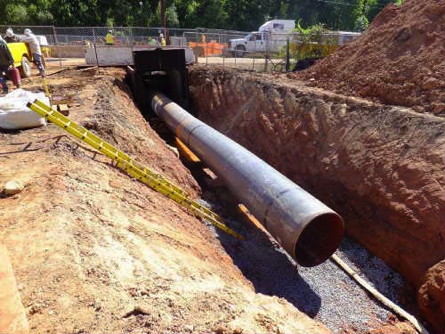
This story is co-published by MetroFocus and Gotham Gazette.
NEW YORK — The first interstate natural gas pipeline to come to New York City in 40 years will deliver gas extracted, in part, from the Marcellus Shale rock formations using the controversial drilling process known as hydraulic fracturing.
The 15.2 miles of new pipeline construction will end at the edge of Manhattan’s West Side, in the Meatpacking District, where it will connect to a new underground Consolidated Edison vault and be distributed through the utility’s system.
But the pipeline, known as the New Jersey-New York Expansion Project, has attracted a series of protests, legal challenges and concern along its proposed route.
Elected officials in Jersey City, including Mayor Jerramiah Healy, have opposed the pipeline on the basis that it would be built too closely to schools, parks and hospitals and could pose a public safety risk. Opponents of hydraulic fracturing, or fracking, fear that increased natural gas use could encourage even more drilling. They also worry that high levels of radon gas will be carried by the pipeline to consumers. A series of last-ditch lawsuits are aiming to stop the project.
Spectra Energy Corp., which is building the pipeline, emphasized that it has nothing to do with the process of extracting gas.
 Marylee Hanley, a spokeswoman for Spectra, compared the company to Fed Ex and added, "We simply are the transportation system and are governed by the regulations of the FERC [Federal Energy Regulatory Commission]. We move the gas along our system. (We are) an open-access pipeline. As long as any party has gas to be moved, we are required to move gas on our system."
Marylee Hanley, a spokeswoman for Spectra, compared the company to Fed Ex and added, "We simply are the transportation system and are governed by the regulations of the FERC [Federal Energy Regulatory Commission]. We move the gas along our system. (We are) an open-access pipeline. As long as any party has gas to be moved, we are required to move gas on our system."
When it goes online next year, the pipeline is expected to carry 800 million cubic feet of natural gas per day to the metropolitan area. Construction of the pipeline began in earnest this summer after Spectra, won approval from federal regulators in May to extend its Texas Eastern Transmission and Algonquin Gas Transmission pipelines.
Cleaner Fuel
The city is betting on the pipeline to help increase its capacity to meet the growing demand for the somewhat cheaper, cleaner fossil fuel.
In an op-ed published last month in The Washington Post, Mayor Michael R. Bloomberg and George Mitchell, a pioneer of hydraulic fracturing, responded to criticism of fracking, saying shale gas production through the method represents “the most significant development in the U.S. energy sector in generations.”
They wrote that not only was it “good for consumers’ pocketbooks” because it lowered the cost of energy, it also “helped stimulate major infrastructure investments” like the New Jersey-New York interstate pipeline.
Consolidated Edison said the Spectra project will provide huge benefits to its customers. "This project will enhance the reliability of our gas system, and help us meet a growing demand for natural gas," said spokesman Michael S. Clendenin in an emailed statement. "This project will also help improve air quality in New York City by allowing more consumers to convert their boilers from oil to natural gas."
The city passed regulations requiring buildings to stop using heavy heating oils and to replace them with an alternative — natural gas, No. 2 heating oil, biodiesel or steam. Buildings were required to begin the process of converting to a cleaner fuel beginning in July.
The city says converting buildings to cleaner fuels — including natural gas — could save hundreds of lives annually by reducing toxic air pollution caused by heavy heating oils.
The Spectra pipeline will deliver fuel for customers of both Consolidated Edison and National Grid, which service all five boroughs of New York City, as well as some parts of Westchester County. The pipeline will run through Linden, N.J., cut across the Arthur Kill strait into Staten Island, return to New Jersey, weave through Bayonne and Jersey City, and make its way across the Hudson River to Manhattan.
Map of the proposed project. Click to enlarge. Image courtesy MetroFocus/Kevon Greene.
It will then run through the Gansevoort Peninsula on the West Side and under the Hudson River Park before it connects with the Con Ed vault near 10th Avenue and Gansevoort Street, not far from where the Whitney Museum is constructing its new building.
Besides distributing gas from shale sources in Pennsylvania, the fuel will come from the Gulf Coast, Canada and the Rocky Mountains, the company says. Experts believe that production could shift over time to 90 percent of natural gas coming from extracting the fuel in the Marcellus and Utica Shales of Pennsylvania and New York.
Democratic Assemblywoman Deborah Glick, who represents the 66th district in Manhattan, which includes where the pipeline will enter the island, said she had received complaints about the project from a number of residents.
“Individuals want you to find a way to stop something they don't believe is good for the community, and many see the pipeline as bad,” she said.
But she said the growth of the city demands that new energy sources be brought online. “New neighborhoods [are] coming to the city and the population is growing, even along the west side,” she said, adding energy has to come from somewhere.
“The country is awash in natural gas, and not all is related to fracking,” she continued, but acknowledged that “clearly the fear is that this will be an avenue for more” fracking.
“The question,” she said, comes down to whether natural gas is going to provide fewer emissions than coal and oil, for example. “But you're polluting either way,” she said, noting that none of these are in fact “clean sources,” despite such language being used by those promoting the energy.
Environmental and Safety Concerns
In an environmental impact study on the proposed pipeline, the Federal Energy Regulatory Commission found that the risks from the pipeline were “minimal.”
“The applicants have demonstrated their project is needed by their willingness to bear the risk that the project’s costs can be recovered without subsidization from existing customers,” FERC said in the study. “The fact that the entire capacity of the proposed NJ-NY Project is subscribed under precedent agreements with 15- to 20-year terms is strong evidence that the market also believes that the project is needed.”
But environmentalists say federal studies have failed to fully account for the dangers of the pipeline, noting in particular the large quantities of carcinogenic radon in Marcellus Shale, which some scientists contend will not fully decompose before it reaches the city.
Spectra said that radon exposure had been reviewed by FERC in its environmental impact study, saying the agency "refers to several studies, including studies by the U.S. Environmental Protection Agency and U.S. Department of Energy, that have concluded radon in natural gas does not pose a health or safety risk to the public.”
But some environmental groups are adamantly opposed to any pipelines that could lead to fracking.
"We have been, and are, opposed to the development of any new infrastructure — such as the pipeline — that facilitate the increased burning of natural gas,” said Frank Eadie, a representative of the New York Chapter of the Sierra Club, which is also considering litigation to stop the project.
While the project gained FERC support after a bruising two-year public relations battle in New Jersey, it is only recently that residents in Manhattan have decided to take legal action against the construction of the pipeline.
Earlier this month, six organizations sued to halt construction, filing an emergency petition in New York State Supreme Court, and calling for a temporary restraining order and injunctive relief against Spectra, Hudson River Park Trust and other groups.
The groups reached a compromise earlier this week over one of the main complaints — that the 24/7 construction at the Gansevoort Peninsula limited bike and pedestrian traffic at the Hudson River Park — after Spectra agreed to place a crossing guard to monitor the trucks entering and exiting the construction site, according to Jeff Zimmmerman, one of the attorneys who filed the original complaint.
He said they are still suing to halt construction, with a judge set to hear arguments in November.
In their lawsuit, along with environmental concerns, the organizations cited the risk of pipeline explosions, giving as an example the 2010 explosion in San Bruno, Calif., that killed eight people and caused millions in property damage.
Spectra says that, unlike the San Bruno pipeline, the New Jersey-New York Expansion Project will be stronger, thicker, buried deeper and will involve 100 percent x-ray inspection of welds.
"So, to compare our pipeline to that in the San Bruno incident is simply not correct," the company said in a presentation on the project it says was shown to Jersey City residents. "We have layers and layers of safety measures built into the design, construction and operation and maintenance."
In July, the U.S. Department of Transportation's Pipeline and Hazardous Materials Safety Administration fined Spectra over $134,000 for safety violations in their pipelines in Texas, Arkansas, Louisiana and the Gulf of Mexico.
Spectra spokeswoman Hanley said the fines stemmed from “corrosion” to the pipelines, but insisted such damage would not be “life-threatening,” though she refrained from elaborating why. She did note that Texas Eastern Transmission, the parent company of Spectra, “will be reviewing policies and procedures and reviewing all of the findings” by the PHMSA.
Of the seven violations in total, three of the findings resulted in the $134,000 in civil penalties. These had to do with maintenance and inspection failings, as well as above-ground monitoring of the area.
The remaining four penalties "involved facility and right-of-way maintenance."
Spectra has long maintained the New Jersey-New York pipeline will be “among the safest in the nation,” pointing to changes in technology available to them, such as a 24-hour monitoring system. Those safeguards meet and often exceed the highest federal safety requirements, the company says.
All told, there have been 62 gas transmission explosions that have resulted in 34 deaths and almost $400 million in damage nationwide since 2000, according to the PHMSA.
The causes of the explosions ranged from external corrosion, damage from negligence, incorrect operation, equipment failure, and natural force, while the cause of a few pipeline explosions remain unknown. The images of the 150-foot flames from the San Bruno, California, explosion, are often highlighted by pipeline opponents when discussing safety.
Experts have also warned about the potential vulnerability of pipelines to terrorist attacks — one example being the foiled attempt to explode a jet fuel pipeline at John F. Kennedy International Airport in 2009.
The U.S. Department of Homeland Security also issued an alert in May about cyber attacks on the control systems of various gas pipelines nationwide. In a DHS newsletter, the agency notes reports of "targeted attempts and intrusions into multiple natural gas pipeline sector organizations.”
____
Sarah Crean and Cristian Salazar contributed to this report. Image of Spectra pipeline being layed extracted from FERC weekly summary compliance report, dated Sept. 10-16, 2012.
